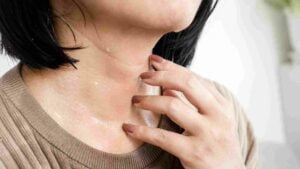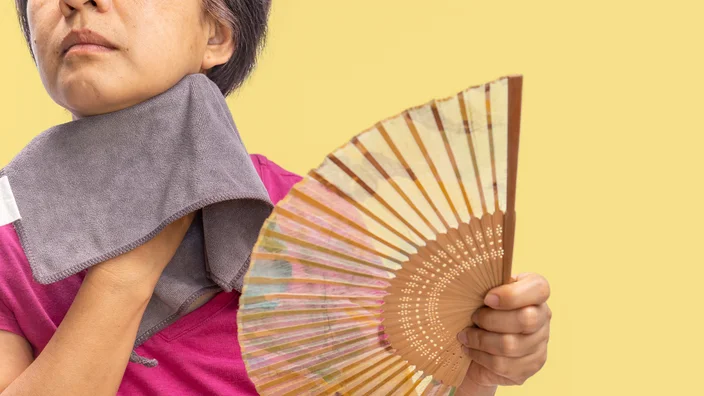Experiencing hot flashes can be more than just uncomfortable; it can be a significant disruption in the daily lives of many. Traditionally, hormone replacement therapy (HRT) has been the go-to solution, but it’s not suitable for everyone. For those seeking alternative methods to manage these sudden waves of heat, non-hormonal treatments offer a ray of hope. This blog delves into the world of non-hormonal treatment for hot flashes, exploring a variety of options that cater to different lifestyles and preferences.
Contents
Importance Of Non-Hormonal Treatment For Hot Flashes
 The importance of non-hormonal treatments for hot flashes lies in their ability to provide relief for those who either cannot or choose not to use hormone replacement therapy (HRT). These treatments offer several key benefits listed below:
The importance of non-hormonal treatments for hot flashes lies in their ability to provide relief for those who either cannot or choose not to use hormone replacement therapy (HRT). These treatments offer several key benefits listed below:
- Alternative for Women with Health Risks
Hormone replacement therapy is not suitable for everyone. Women with a history of certain types of cancer (like breast or endometrial cancer), cardiovascular disease, liver disease, or a risk of blood clots are often advised against HRT.
- Long-Term Solution
For women who have experienced hot flashes for many years, non-hormonal treatments can be a more suitable long-term solution. While HRT is often recommended for short-term use due to long-term risks, non-hormonal options can be used for extended periods with fewer concerns.
- Breast Cancer Survivors
Women who have had hormone-sensitive cancers often experience menopausal symptoms as a result of their treatment but cannot use HRT due to the risk of cancer recurrence. Non-hormonal treatments provide crucial relief for these individuals.
- Fewer Side Effects
Non-hormonal treatments may have fewer or less severe side effects compared to HRT. For example, some women might experience side effects from HRT like breast tenderness, nausea, or headaches, which can be avoided with non-hormonal options.
- Psychological Comfort and Empowerment
Many women find psychological comfort and a sense of empowerment in managing menopausal symptoms with non-hormonal treatments. It allows them to take control of their health in a way that aligns with their personal values and health goals.
All in all, non-hormonal treatment for hot flashes is crucial as it provides safe, effective, and personalized options for managing a common and often disruptive menopausal symptom.
Non-Hormonal Treatment For Hot Flashes
 Treating hot flashes without hormones often involves making specific lifestyle changes. These adjustments can significantly help in reducing the frequency and severity of hot flashes. Here are some key lifestyle strategies:
Treating hot flashes without hormones often involves making specific lifestyle changes. These adjustments can significantly help in reducing the frequency and severity of hot flashes. Here are some key lifestyle strategies:
Lifestyle Changes
Dietary changes are crucial; avoiding known triggers like spicy foods, caffeine, and alcohol can help. These substances are known to dilate blood vessels and increase body temperature. Incorporating phytoestrogens (plant estrogens), found in foods like soy, may also help some women, as they can have a mild estrogen-like effect on the body. Regular physical activity is not only good for overall health but can also balance hormones and improve mood, potentially reducing the severity of hot flashes. Additionally, weight management is important, as excess body weight can insulate heat and exacerbate symptoms.
Natural Remedies
Many women turn to herbal supplements for relief. Black cohosh, a herb that has been used for centuries to treat women’s health issues, is popular for managing menopausal symptoms, including hot flashes. Red clover and evening primrose oil are other herbal options some find helpful. However, the effectiveness and safety of these supplements can vary, and they’re not regulated with the same rigor as prescription medications. So it’s important to discuss their use with a healthcare provider.
Acupuncture
Acupuncture, a traditional Chinese medicine practice, involves inserting thin needles into specific points on the body. It’s thought to work by stimulating the body’s natural healing processes. Some women find that acupuncture helps reduce the frequency and severity of their hot flashes. The theory is that acupuncture may affect the brain’s release of neurotransmitters and hormones, thus regulating body temperature. While scientific studies have yielded mixed results, many women report subjective improvement in their symptoms.
Stress Reduction
Stress is a well-known trigger for hot flashes, and managing stress can significantly reduce their frequency and intensity. Techniques like mindfulness, meditation, and cognitive-behavioral therapy (CBT) are effective in managing stress levels. Mindfulness and meditation can help calm the mind and regulate the body’s response to stress, potentially lessening the occurrence of hot flashes. CBT, on the other hand, can be particularly useful in changing the way one perceives and reacts to the onset of hot flashes, thereby reducing their impact.
Stay Hydrated
Staying well-hydrated is essential for overall health and can be particularly helpful in managing hot flashes. Drinking plenty of water helps regulate body temperature and can reduce the intensity of a hot flash when it occurs. Some women find that sipping cold water at the start of a hot flash can help lessen its severity. Additionally, avoiding dehydrating beverages like alcohol and caffeine can also be beneficial, as they can exacerbate the symptoms.
Avoid Smoking
Smoking has been linked to an increase in the frequency and severity of hot flashes. This is because nicotine affects blood vessels and can alter the body’s temperature regulation. Quitting smoking not only reduces hot flashes but also brings a multitude of other health benefits, including a lower risk of heart disease, stroke, and cancer. For those struggling to quit smoking, various support systems, including counseling, medications, and nicotine replacement therapies, can be effective.
Cooling Products
There are a variety of over-the-counter products designed to provide immediate relief during a hot flash. These include cooling sprays, gels, and wearable items like cooling scarves or vests. These products work by drawing heat away from the body, providing a cooling sensation that can be particularly relieving during a hot flash. Some women also find relief using cooling pillows or mattress pads at night, which can help manage night sweats and improve sleep quality.
Each of these strategies can be part of a comprehensive approach to managing hot flashes without hormones. It’s important to remember that the effectiveness of these methods can vary from person to person. And what works for one individual may not work for another. Consulting with a healthcare provider is always recommended to ensure a safe and effective treatment plan.
Examples of Non-Hormonal Medicines For Hot Flashes
 Several non-hormonal medications have been found effective in treating hot flashes. These medications are often used for other primary purposes but have shown efficacy in reducing the frequency and severity of hot flashes as well. Here are some examples:
Several non-hormonal medications have been found effective in treating hot flashes. These medications are often used for other primary purposes but have shown efficacy in reducing the frequency and severity of hot flashes as well. Here are some examples:
1. Antidepressants
- Selective Serotonin Reuptake Inhibitors (SSRIs): Drugs like paroxetine (Brisdelle, Paxil) and escitalopram (Lexapro) have been used for treating hot flashes. They work by altering the levels of serotonin, a neurotransmitter that can affect body temperature.
- Serotonin-Norepinephrine Reuptake Inhibitors (SNRIs): Venlafaxine (Effexor XR) is an example of an SNRI that has been effective in treating hot flashes. It affects both serotonin and norepinephrine levels in the brain.
2. Gabapentin
- Originally used to treat seizures, gabapentin (Neurontin, Gralise) has been found to help in reducing hot flashes. It’s particularly noted for its effectiveness in treating night sweats and hot flashes that disturb sleep.
3. Clonidine
- Clonidine (Catapres, Kapvay) is a medication primarily used to treat high blood pressure but can also help reduce the frequency of hot flashes. It works by decreasing the responsiveness of the blood vessels to stimuli that cause them to constrict, thereby reducing the intensity of hot flashes.
4. Oxybutynin
- Oxybutynin (Ditropan) is typically used for urinary conditions like overactive bladder but has shown promise in managing hot flashes. It works by relaxing the muscles of the bladder, and its effect on the body’s sweating mechanism can help alleviate hot flashes.
It’s important to note that while these medications can be effective, they may have side effects and may not be suitable for everyone. Their use for treating hot flashes is often considered “off-label,” meaning it’s not the primary approved use of the drug.
Conclusion
In conclusion, managing hot flashes without hormones is a viable and effective approach for many women. With a variety of options ranging from lifestyle changes and natural remedies to non-hormonal medications, there’s a solution for everyone’s needs and preferences. These methods offer a safer alternative for those who cannot use hormone therapy. Hence, aligns with a more natural health philosophy, and provides relief with fewer side effects.
By exploring these non-hormonal treatments, women can find comfort and empowerment in navigating through menopause. Ultimately, ensuring a better quality of life during this transitional phase. If you are facing menopause-related issues, menopause treatment at HerMantra can help. Book your free trial online menopause treatment session now.


